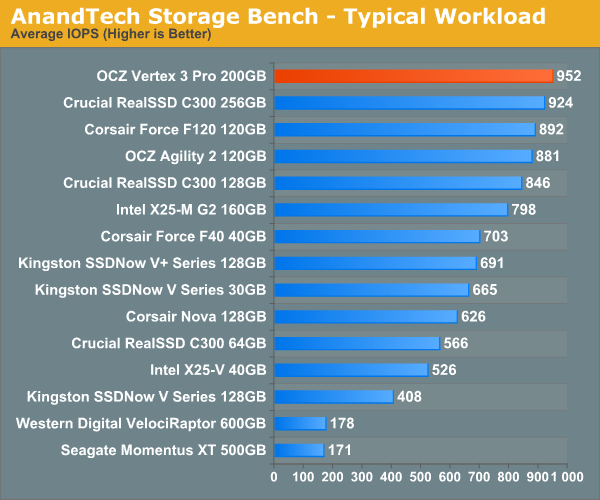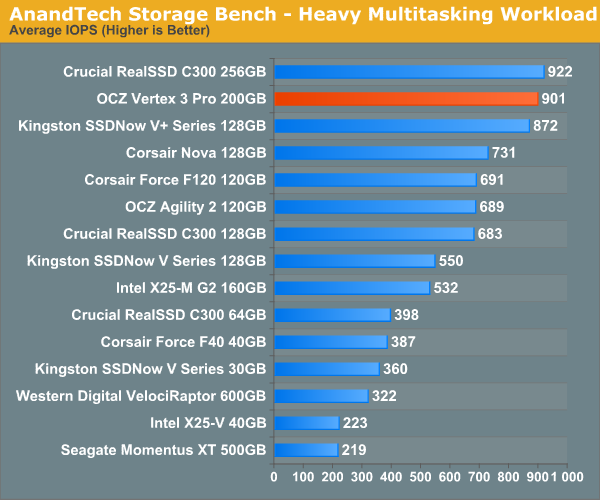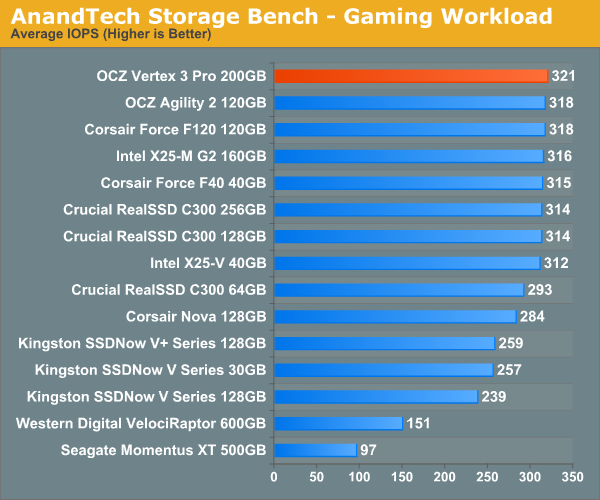OCZ Vertex 3 Pro Preview: The First SF-2500 SSD
by Anand Lal Shimpi on February 17, 2011 3:01 AM ESTAnandTech Storage Bench 2010
To keep things consistent we've also included our older Storage Bench. Note that the old storage test system doesn't have a SATA 6Gbps controller, so we only have one result for the Vertex 3 Pro (and the C300). The SF-2500 controller does respectably here, but with a 3Gbps controller we're only marginally faster than other SSDs (which is why we've moved to a new storage platform for 2011).
The first in our benchmark suite is a light/typical usage case. The Windows 7 system is loaded with Firefox, Office 2007 and Adobe Reader among other applications. With Firefox we browse web pages like Facebook, AnandTech, Digg and other sites. Outlook is also running and we use it to check emails, create and send a message with a PDF attachment. Adobe Reader is used to view some PDFs. Excel 2007 is used to create a spreadsheet, graphs and save the document. The same goes for Word 2007. We open and step through a presentation in PowerPoint 2007 received as an email attachment before saving it to the desktop. Finally we watch a bit of a Firefly episode in Windows Media Player 11.
There’s some level of multitasking going on here but it’s not unreasonable by any means. Generally the application tasks proceed linearly, with the exception of things like web browsing which may happen in between one of the other tasks.
The recording is played back on all of our drives here today. Remember that we’re isolating disk performance, all we’re doing is playing back every single disk access that happened in that ~5 minute period of usage. The light workload is composed of 37,501 reads and 20,268 writes. Over 30% of the IOs are 4KB, 11% are 16KB, 22% are 32KB and approximately 13% are 64KB in size. Less than 30% of the operations are absolutely sequential in nature. Average queue depth is 6.09 IOs.
The performance results are reported in average I/O Operations per Second (IOPS):

If there’s a light usage case there’s bound to be a heavy one. In this test we have Microsoft Security Essentials running in the background with real time virus scanning enabled. We also perform a quick scan in the middle of the test. Firefox, Outlook, Excel, Word and Powerpoint are all used the same as they were in the light test. We add Photoshop CS4 to the mix, opening a bunch of 12MP images, editing them, then saving them as highly compressed JPGs for web publishing. Windows 7’s picture viewer is used to view a bunch of pictures on the hard drive. We use 7-zip to create and extract .7z archives. Downloading is also prominently featured in our heavy test; we download large files from the Internet during portions of the benchmark, as well as use uTorrent to grab a couple of torrents. Some of the applications in use are installed during the benchmark, Windows updates are also installed. Towards the end of the test we launch World of Warcraft, play for a few minutes, then delete the folder. This test also takes into account all of the disk accesses that happen while the OS is booting.
The benchmark is 22 minutes long and it consists of 128,895 read operations and 72,411 write operations. Roughly 44% of all IOs were sequential. Approximately 30% of all accesses were 4KB in size, 12% were 16KB in size, 14% were 32KB and 20% were 64KB. Average queue depth was 3.59.

The gaming workload is made up of 75,206 read operations and only 4,592 write operations. Only 20% of the accesses are 4KB in size, nearly 40% are 64KB and 20% are 32KB. A whopping 69% of the IOs are sequential, meaning this is predominantly a sequential read benchmark. The average queue depth is 7.76 IOs.











144 Comments
View All Comments
Chloiber - Thursday, February 17, 2011 - link
It's correct, Anand answered the exact same question already on page 1/2 of the comments.7Enigma - Thursday, February 17, 2011 - link
Yup, saw that on my second read through. A little clarification in the article would have made it a bit more explainable but at least the numbers are right.teldar - Thursday, February 17, 2011 - link
Hope this gets seen.I used to go to a site frequently for info on drive reliability.
storagereview.com
I don't believe its really being updated anymore. I would love to side you be able to integrate a site like theirs (or theirs completely) into here.
argosreality - Thursday, February 17, 2011 - link
They've been updating the site for the last six months or so with new reviews. Actually, they just reviewed the new Vertex2 drives with 25nm flashtomoyo - Friday, February 18, 2011 - link
Ya storagereview is quite alive now. They were dead for over a year, but I'm glad to have another good source of hdd/ssd info again.KenPC - Thursday, February 17, 2011 - link
OCZ needs a distraction - NOWSo serve up a prototype (even without a case yet) drive and get fabulous bench results and lots of press to drown out the behind the scenes downgrading of many of the on-market products.
Yes, this new controller/architecture for this particular prototype is faster. Yes, it appears to be very promising technology in the SSD space.
But now folks will be using THIS prototype review to measure the purchase decisions for drives sold months from now that may/may not have the same performance
MeSh1 - Thursday, February 17, 2011 - link
Wow, thats some tasty hardware :). 400GB @ $1350. The Revo X22 480GB is just under that, hmm..... decisions. Revo Drive uses SF1200 I wonder if they can slap a SF200 on the Revo :)Breit - Friday, February 18, 2011 - link
you can bet on that. ocz will definitely roll out a new revodrive with sf2000 on it when the time comes, trust me. :)geniekid - Thursday, February 17, 2011 - link
Don't know if anyone from AT will get this far in the comments, but...1) I like how the beginning of the article rehashes how SSDs work instead of linking back to earlier articles. The redundancy makes it a lot easier to read the article.
2) I think the real world usage of these things is invaluable. Theoretical limits almost never ever mirror real world usage. *Thumbs up*
TrackSmart - Friday, February 18, 2011 - link
I agree completely on the REAL WORLD tests. Looking at the PCMark Vantage scores, it's clear that the incredible speeds of the Vertex 3 will only yield marginal gains in *total system performance* compared to the current crop of SSDs (Agility 2, Vertex 2, etc). Hopefully the price of the new drives will be similar to the old ones. Or lower, forcing even more affordable pricing on the existing, fast-enough models.